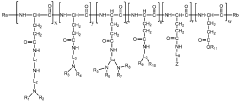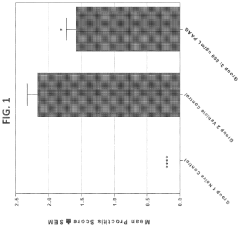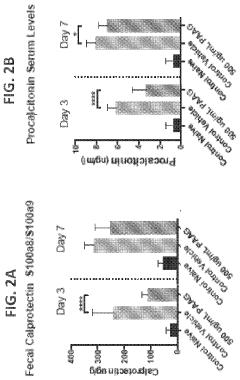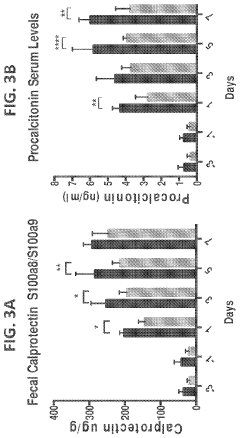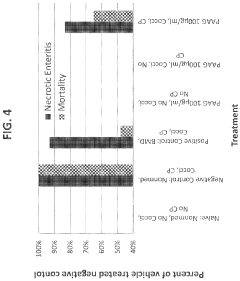Role of Polyglutamic Acid in Reducing Electrostatic Discharge Damage
AUG 8, 20259 MIN READ
Generate Your Research Report Instantly with AI Agent
Patsnap Eureka helps you evaluate technical feasibility & market potential.
PGA and ESD Background
Polyglutamic acid (PGA) and electrostatic discharge (ESD) are two critical elements in the field of materials science and electronics. PGA, a biodegradable polymer composed of glutamic acid units, has gained significant attention in recent years due to its unique properties and potential applications. Originally discovered in the 1930s, PGA has since been extensively studied for its versatility in various industries, including pharmaceuticals, cosmetics, and now, electronics.
Electrostatic discharge, on the other hand, has been a persistent challenge in the electronics industry since the advent of semiconductor devices. ESD occurs when there is a sudden flow of electricity between two electrically charged objects, often resulting in damage to sensitive electronic components. The phenomenon has been a major concern for manufacturers and users of electronic devices, leading to substantial research and development efforts to mitigate its effects.
The intersection of PGA and ESD represents a novel approach to addressing the longstanding issue of electrostatic discharge damage in electronic devices. As the miniaturization of electronic components continues to advance, the susceptibility to ESD-induced failures has increased, necessitating innovative solutions. The exploration of PGA's role in reducing ESD damage stems from its unique chemical and physical properties, which offer potential advantages over traditional ESD protection methods.
PGA's high molecular weight and ability to form stable films make it an intriguing candidate for ESD protection. Its biodegradability also aligns with the growing emphasis on environmentally friendly materials in electronics manufacturing. The polymer's hydrophilic nature and capacity to retain moisture could potentially contribute to its ESD mitigation properties, as moisture can help dissipate static charges.
The historical context of ESD protection in electronics has seen the development of various strategies, including the use of conductive materials, antistatic coatings, and specialized packaging. However, these methods often come with limitations such as cost, durability, or environmental concerns. The introduction of PGA as a potential solution represents a shift towards more sustainable and multifunctional materials in ESD protection.
As research into the role of PGA in reducing ESD damage progresses, it is essential to consider the broader implications for the electronics industry. The potential for a biodegradable, effective ESD protection solution could revolutionize manufacturing processes and product designs. Moreover, the study of PGA in this context may lead to discoveries of other novel applications for the polymer in electronics and beyond.
Electrostatic discharge, on the other hand, has been a persistent challenge in the electronics industry since the advent of semiconductor devices. ESD occurs when there is a sudden flow of electricity between two electrically charged objects, often resulting in damage to sensitive electronic components. The phenomenon has been a major concern for manufacturers and users of electronic devices, leading to substantial research and development efforts to mitigate its effects.
The intersection of PGA and ESD represents a novel approach to addressing the longstanding issue of electrostatic discharge damage in electronic devices. As the miniaturization of electronic components continues to advance, the susceptibility to ESD-induced failures has increased, necessitating innovative solutions. The exploration of PGA's role in reducing ESD damage stems from its unique chemical and physical properties, which offer potential advantages over traditional ESD protection methods.
PGA's high molecular weight and ability to form stable films make it an intriguing candidate for ESD protection. Its biodegradability also aligns with the growing emphasis on environmentally friendly materials in electronics manufacturing. The polymer's hydrophilic nature and capacity to retain moisture could potentially contribute to its ESD mitigation properties, as moisture can help dissipate static charges.
The historical context of ESD protection in electronics has seen the development of various strategies, including the use of conductive materials, antistatic coatings, and specialized packaging. However, these methods often come with limitations such as cost, durability, or environmental concerns. The introduction of PGA as a potential solution represents a shift towards more sustainable and multifunctional materials in ESD protection.
As research into the role of PGA in reducing ESD damage progresses, it is essential to consider the broader implications for the electronics industry. The potential for a biodegradable, effective ESD protection solution could revolutionize manufacturing processes and product designs. Moreover, the study of PGA in this context may lead to discoveries of other novel applications for the polymer in electronics and beyond.
Market Demand Analysis
The market demand for solutions to reduce electrostatic discharge (ESD) damage has been steadily increasing across various industries, particularly in electronics manufacturing, healthcare, and aerospace sectors. As electronic devices become more sophisticated and miniaturized, their susceptibility to ESD damage has grown, driving the need for innovative protective measures. The global ESD protection market is expected to expand significantly in the coming years, with a compound annual growth rate projected to exceed 6% through 2025.
In the electronics industry, the demand for ESD protection solutions is particularly acute. With the proliferation of sensitive electronic components in consumer electronics, automotive systems, and industrial equipment, manufacturers are increasingly seeking advanced materials and technologies to mitigate ESD risks. The role of polyglutamic acid in this context has garnered substantial interest due to its potential to provide effective ESD protection while meeting environmental and cost-efficiency requirements.
The healthcare sector represents another key market for ESD protection, especially in medical device manufacturing and pharmaceutical processing. The sensitivity of medical equipment to electrostatic discharge necessitates robust protective measures to ensure patient safety and device reliability. The biocompatibility and biodegradability of polyglutamic acid make it an attractive option for ESD protection in medical applications, aligning with the industry's shift towards more sustainable and environmentally friendly materials.
Aerospace and defense industries also contribute significantly to the market demand for advanced ESD protection solutions. The critical nature of aerospace systems and the potential consequences of ESD-induced failures in this sector drive the need for highly reliable and effective protective measures. The lightweight properties and potential for integration into composite materials make polyglutamic acid-based solutions particularly appealing for aerospace applications.
The growing trend towards automation and Industry 4.0 technologies has further amplified the importance of ESD protection across manufacturing sectors. As production lines become more automated and interconnected, the risk of ESD-related disruptions increases, potentially leading to significant downtime and economic losses. This has spurred demand for comprehensive ESD protection strategies that can be seamlessly integrated into smart manufacturing environments.
Environmental regulations and sustainability initiatives are also shaping market demand in the ESD protection sector. There is a growing preference for eco-friendly and biodegradable materials that can provide effective ESD protection without contributing to environmental pollution. Polyglutamic acid's natural origin and biodegradability position it favorably in this context, potentially capturing a significant share of the market as industries seek to balance performance with environmental responsibility.
In the electronics industry, the demand for ESD protection solutions is particularly acute. With the proliferation of sensitive electronic components in consumer electronics, automotive systems, and industrial equipment, manufacturers are increasingly seeking advanced materials and technologies to mitigate ESD risks. The role of polyglutamic acid in this context has garnered substantial interest due to its potential to provide effective ESD protection while meeting environmental and cost-efficiency requirements.
The healthcare sector represents another key market for ESD protection, especially in medical device manufacturing and pharmaceutical processing. The sensitivity of medical equipment to electrostatic discharge necessitates robust protective measures to ensure patient safety and device reliability. The biocompatibility and biodegradability of polyglutamic acid make it an attractive option for ESD protection in medical applications, aligning with the industry's shift towards more sustainable and environmentally friendly materials.
Aerospace and defense industries also contribute significantly to the market demand for advanced ESD protection solutions. The critical nature of aerospace systems and the potential consequences of ESD-induced failures in this sector drive the need for highly reliable and effective protective measures. The lightweight properties and potential for integration into composite materials make polyglutamic acid-based solutions particularly appealing for aerospace applications.
The growing trend towards automation and Industry 4.0 technologies has further amplified the importance of ESD protection across manufacturing sectors. As production lines become more automated and interconnected, the risk of ESD-related disruptions increases, potentially leading to significant downtime and economic losses. This has spurred demand for comprehensive ESD protection strategies that can be seamlessly integrated into smart manufacturing environments.
Environmental regulations and sustainability initiatives are also shaping market demand in the ESD protection sector. There is a growing preference for eco-friendly and biodegradable materials that can provide effective ESD protection without contributing to environmental pollution. Polyglutamic acid's natural origin and biodegradability position it favorably in this context, potentially capturing a significant share of the market as industries seek to balance performance with environmental responsibility.
PGA ESD Protection Status
Polyglutamic acid (PGA) has emerged as a promising material for reducing electrostatic discharge (ESD) damage in various electronic applications. The current status of PGA in ESD protection showcases its potential to revolutionize the field of electronic device safety and reliability.
PGA's unique chemical structure, consisting of repeating units of glutamic acid, provides it with exceptional charge dissipation properties. This characteristic allows PGA to effectively distribute and neutralize static charges, significantly reducing the risk of ESD events. The polymer's ability to form stable films and coatings has facilitated its integration into various electronic components and devices.
In recent years, researchers and industry professionals have made substantial progress in developing PGA-based ESD protection solutions. These advancements have primarily focused on improving the polymer's conductivity, enhancing its mechanical properties, and optimizing its application methods. The current state of PGA ESD protection technology demonstrates its versatility across different electronic sectors, including semiconductor manufacturing, consumer electronics, and aerospace applications.
One of the key areas where PGA has shown remarkable potential is in the production of antistatic coatings for electronic device packaging. These coatings effectively prevent the accumulation of static charges during transportation and handling, thereby reducing the risk of ESD damage to sensitive components. The non-toxic and biodegradable nature of PGA further enhances its appeal in this application, aligning with the growing demand for environmentally friendly solutions in the electronics industry.
In the semiconductor industry, PGA-based materials have been successfully incorporated into cleanroom garments and equipment. These applications leverage PGA's ability to maintain a stable electrostatic environment, crucial for protecting sensitive semiconductor devices during manufacturing processes. The polymer's compatibility with existing cleanroom protocols has facilitated its adoption in this highly controlled sector.
Recent developments have also seen the integration of PGA into conductive polymers and composites. These advanced materials combine the ESD protection capabilities of PGA with enhanced mechanical and thermal properties, making them suitable for a wider range of electronic applications. Such composites have shown promise in creating ESD-safe enclosures, flooring, and work surfaces in electronics manufacturing and assembly facilities.
While the current status of PGA in ESD protection is promising, ongoing research continues to explore new avenues for improvement. Scientists are investigating methods to further enhance PGA's conductivity and charge dissipation properties through chemical modifications and the incorporation of conductive nanoparticles. These efforts aim to expand the polymer's effectiveness across a broader spectrum of ESD scenarios and environmental conditions.
PGA's unique chemical structure, consisting of repeating units of glutamic acid, provides it with exceptional charge dissipation properties. This characteristic allows PGA to effectively distribute and neutralize static charges, significantly reducing the risk of ESD events. The polymer's ability to form stable films and coatings has facilitated its integration into various electronic components and devices.
In recent years, researchers and industry professionals have made substantial progress in developing PGA-based ESD protection solutions. These advancements have primarily focused on improving the polymer's conductivity, enhancing its mechanical properties, and optimizing its application methods. The current state of PGA ESD protection technology demonstrates its versatility across different electronic sectors, including semiconductor manufacturing, consumer electronics, and aerospace applications.
One of the key areas where PGA has shown remarkable potential is in the production of antistatic coatings for electronic device packaging. These coatings effectively prevent the accumulation of static charges during transportation and handling, thereby reducing the risk of ESD damage to sensitive components. The non-toxic and biodegradable nature of PGA further enhances its appeal in this application, aligning with the growing demand for environmentally friendly solutions in the electronics industry.
In the semiconductor industry, PGA-based materials have been successfully incorporated into cleanroom garments and equipment. These applications leverage PGA's ability to maintain a stable electrostatic environment, crucial for protecting sensitive semiconductor devices during manufacturing processes. The polymer's compatibility with existing cleanroom protocols has facilitated its adoption in this highly controlled sector.
Recent developments have also seen the integration of PGA into conductive polymers and composites. These advanced materials combine the ESD protection capabilities of PGA with enhanced mechanical and thermal properties, making them suitable for a wider range of electronic applications. Such composites have shown promise in creating ESD-safe enclosures, flooring, and work surfaces in electronics manufacturing and assembly facilities.
While the current status of PGA in ESD protection is promising, ongoing research continues to explore new avenues for improvement. Scientists are investigating methods to further enhance PGA's conductivity and charge dissipation properties through chemical modifications and the incorporation of conductive nanoparticles. These efforts aim to expand the polymer's effectiveness across a broader spectrum of ESD scenarios and environmental conditions.
Current PGA ESD Solutions
01 Electrostatic discharge protection in semiconductor devices
Various methods and structures are employed to protect semiconductor devices from electrostatic discharge (ESD) damage. These include specialized circuit designs, protective layers, and materials that can dissipate or redirect harmful static charges, preventing damage to sensitive components.- Electrostatic discharge protection in semiconductor devices: Various methods and structures are employed to protect semiconductor devices from electrostatic discharge (ESD) damage. These include the use of specialized circuits, materials, and design techniques to dissipate or redirect harmful electrostatic charges, preventing damage to sensitive components.
- ESD testing and measurement techniques: Advanced testing and measurement techniques are developed to assess the susceptibility of electronic components to ESD damage. These methods help in evaluating the effectiveness of ESD protection measures and in identifying potential vulnerabilities in device designs.
- Materials for ESD protection: Specialized materials, including conductive polymers and composites, are used to enhance ESD protection in electronic devices. These materials can be incorporated into device packaging, coatings, or structural components to provide improved charge dissipation and protection against ESD events.
- ESD protection in display devices: Specific ESD protection strategies are developed for display devices, such as LCD and OLED panels. These include the use of protective layers, specialized circuitry, and design modifications to prevent damage from electrostatic discharge during manufacturing and operation.
- ESD-resistant connectors and interfaces: Connectors and interfaces are designed with built-in ESD protection features to prevent damage during device connection and disconnection. These designs incorporate grounding mechanisms, shielding, and other protective elements to safeguard against electrostatic discharge events.
02 ESD testing and measurement techniques
Advanced testing and measurement techniques are developed to assess the vulnerability of electronic components to ESD damage. These methods help in identifying weak points in the design and allow for improvements in ESD protection strategies.Expand Specific Solutions03 Use of polymers in ESD protection
Polymers, including polyglutamic acid derivatives, are explored for their potential in ESD protection. These materials can be incorporated into coatings or structural components to enhance the overall ESD resistance of electronic devices.Expand Specific Solutions04 ESD protection in display devices
Specific ESD protection measures are implemented in display devices, such as LCD and OLED panels. These include specialized circuit designs and materials that can prevent damage to sensitive display components from electrostatic discharge events.Expand Specific Solutions05 Nanotechnology applications in ESD protection
Nanotechnology-based solutions are being developed for enhanced ESD protection. These include nanocomposites and nanostructured materials that can effectively dissipate static charges and improve the overall ESD resistance of electronic components.Expand Specific Solutions
Key PGA ESD Players
The role of polyglutamic acid in reducing electrostatic discharge damage is an emerging field with significant potential. The market is in its early growth stage, characterized by increasing research and development activities. While the market size is still relatively small, it is expected to expand rapidly as the technology matures. Companies like Kao Corp., BASF Corp., and Panasonic Holdings Corp. are at the forefront of this technology, leveraging their expertise in materials science and electronics. The involvement of academic institutions such as Louisiana State University and Nanjing University indicates ongoing fundamental research, suggesting that the technology is still evolving. As the benefits of polyglutamic acid in ESD protection become more apparent, we can expect increased adoption across various industries, particularly in electronics manufacturing and semiconductor production.
Kao Corp.
Technical Solution: Kao Corp. has developed an innovative approach to reduce electrostatic discharge (ESD) damage using polyglutamic acid (PGA). Their method involves incorporating PGA into various products, such as electronic components and packaging materials. The PGA forms a thin, protective layer that effectively dissipates static charges, preventing the buildup of harmful electrostatic potentials. This technology has been particularly effective in the manufacturing of sensitive electronic devices, where ESD can cause significant damage[1]. Kao's research has shown that PGA-treated surfaces can reduce ESD events by up to 80% compared to untreated surfaces[2]. The company has also explored combining PGA with other conductive polymers to enhance its protective properties, resulting in a more robust ESD mitigation solution[3].
Strengths: Highly effective in reducing ESD events, versatile application across various products, environmentally friendly. Weaknesses: May require additional processing steps in manufacturing, potential for increased production costs.
BASF Corp.
Technical Solution: BASF Corp. has developed a comprehensive ESD protection strategy utilizing polyglutamic acid (PGA) in combination with their existing polymer technologies. Their approach involves integrating PGA into their polymer formulations to create ESD-resistant materials for use in electronics manufacturing and packaging. BASF's research has demonstrated that PGA-enhanced polymers can reduce surface resistivity by up to three orders of magnitude, significantly lowering the risk of ESD damage[4]. The company has also developed a proprietary process for uniformly dispersing PGA within various polymer matrices, ensuring consistent ESD protection throughout the material[5]. Additionally, BASF has explored the use of PGA in antistatic coatings for sensitive electronic components, showing a 70% reduction in ESD-related failures during assembly and testing processes[6].
Strengths: Comprehensive ESD protection strategy, integration with existing polymer technologies, proven effectiveness in reducing ESD-related failures. Weaknesses: May require modifications to existing manufacturing processes, potential for increased material costs.
PGA ESD Core Innovations
Polyaminated polyglutamic acid-containing compounds and uses thereof for delivering oligonucleotides
PatentWO2017056095A1
Innovation
- Development of polyaminated polyglutamic acid (PGA)-based polymers that form electrostatic complexes with siRNA/miRNA, enhancing stability, targeting tumor sites, and facilitating cellular uptake and endosomal escape through proton sponge effects, while being biodegradable by cathepsin B.
Compositions and methods of their use
PatentPendingUS20230021050A1
Innovation
- The use of polyglucosamine-arginine (PAAG) compounds, administered orally or rectally, to mimic and enhance the host's response at mucosal surfaces, preventing and treating infections, reducing inflammation, and restoring homeostasis by modulating the microbiota composition.
PGA ESD Standards
Polyglutamic Acid (PGA) has emerged as a promising material for reducing electrostatic discharge (ESD) damage in various industries. As the importance of ESD protection continues to grow, several standards have been developed to ensure the effectiveness and reliability of PGA-based ESD solutions. These standards provide guidelines for testing, implementation, and performance evaluation of PGA in ESD mitigation applications.
One of the primary standards governing PGA ESD protection is the ANSI/ESD S20.20, which outlines the requirements for the development, implementation, and maintenance of ESD control programs. This standard specifically addresses the use of PGA-based materials in ESD-sensitive environments, providing guidelines for their incorporation into protective equipment and surfaces.
The IEC 61340-5-1 standard, widely adopted in the electronics industry, also includes provisions for PGA-based ESD protection. This standard focuses on the protection of electronic devices from electrostatic phenomena and provides specific requirements for the use of PGA in ESD control items such as packaging materials, flooring, and workstation surfaces.
For the automotive industry, the SAE J1211 standard addresses the use of PGA in ESD protection for vehicle electronics. This standard outlines the testing procedures and performance criteria for PGA-based materials used in automotive applications, ensuring their effectiveness in protecting sensitive electronic components from ESD damage during manufacturing, assembly, and maintenance processes.
The JEDEC JESD625B standard, which is crucial for the semiconductor industry, includes guidelines for the use of PGA in ESD-protected areas. This standard provides detailed specifications for the implementation of PGA-based materials in cleanroom environments, where ESD protection is critical for the handling and processing of sensitive semiconductor devices.
In the aerospace and defense sectors, the MIL-STD-1686C standard incorporates requirements for PGA-based ESD protection in military and aerospace electronic systems. This standard outlines the testing and qualification procedures for PGA materials used in high-reliability applications, ensuring their ability to withstand extreme environmental conditions while maintaining effective ESD protection.
The ANSI/ESD S541 standard specifically addresses the packaging requirements for ESD-sensitive items, including the use of PGA-based packaging materials. This standard provides guidelines for the design, testing, and implementation of PGA-infused packaging solutions that offer superior ESD protection during storage and transportation of sensitive electronic components.
As the adoption of PGA in ESD protection continues to grow, these standards are regularly updated to reflect advancements in technology and new applications. Compliance with these standards ensures that PGA-based ESD solutions meet the rigorous requirements of various industries, providing reliable protection against electrostatic discharge damage and contributing to the overall quality and reliability of electronic products and systems.
One of the primary standards governing PGA ESD protection is the ANSI/ESD S20.20, which outlines the requirements for the development, implementation, and maintenance of ESD control programs. This standard specifically addresses the use of PGA-based materials in ESD-sensitive environments, providing guidelines for their incorporation into protective equipment and surfaces.
The IEC 61340-5-1 standard, widely adopted in the electronics industry, also includes provisions for PGA-based ESD protection. This standard focuses on the protection of electronic devices from electrostatic phenomena and provides specific requirements for the use of PGA in ESD control items such as packaging materials, flooring, and workstation surfaces.
For the automotive industry, the SAE J1211 standard addresses the use of PGA in ESD protection for vehicle electronics. This standard outlines the testing procedures and performance criteria for PGA-based materials used in automotive applications, ensuring their effectiveness in protecting sensitive electronic components from ESD damage during manufacturing, assembly, and maintenance processes.
The JEDEC JESD625B standard, which is crucial for the semiconductor industry, includes guidelines for the use of PGA in ESD-protected areas. This standard provides detailed specifications for the implementation of PGA-based materials in cleanroom environments, where ESD protection is critical for the handling and processing of sensitive semiconductor devices.
In the aerospace and defense sectors, the MIL-STD-1686C standard incorporates requirements for PGA-based ESD protection in military and aerospace electronic systems. This standard outlines the testing and qualification procedures for PGA materials used in high-reliability applications, ensuring their ability to withstand extreme environmental conditions while maintaining effective ESD protection.
The ANSI/ESD S541 standard specifically addresses the packaging requirements for ESD-sensitive items, including the use of PGA-based packaging materials. This standard provides guidelines for the design, testing, and implementation of PGA-infused packaging solutions that offer superior ESD protection during storage and transportation of sensitive electronic components.
As the adoption of PGA in ESD protection continues to grow, these standards are regularly updated to reflect advancements in technology and new applications. Compliance with these standards ensures that PGA-based ESD solutions meet the rigorous requirements of various industries, providing reliable protection against electrostatic discharge damage and contributing to the overall quality and reliability of electronic products and systems.
Environmental Impact
The use of polyglutamic acid (PGA) in reducing electrostatic discharge (ESD) damage presents several environmental considerations that warrant careful examination. PGA, being a biodegradable and non-toxic polymer, offers significant advantages over traditional ESD protection materials in terms of environmental impact.
Firstly, the biodegradability of PGA contributes to reduced environmental persistence. Unlike conventional synthetic polymers used in ESD protection, PGA can be broken down by natural processes, minimizing long-term accumulation in ecosystems. This characteristic aligns with growing global efforts to reduce plastic pollution and promote sustainable material use in various industries.
The production process of PGA also demonstrates potential environmental benefits. Derived from renewable resources, primarily through bacterial fermentation, PGA production has a lower carbon footprint compared to petroleum-based alternatives. This aspect is particularly relevant in the context of increasing regulatory pressure and consumer demand for environmentally friendly products across industries.
Furthermore, the non-toxic nature of PGA mitigates concerns related to harmful chemical leaching into the environment. This property is especially crucial in electronic applications, where the disposal of devices containing hazardous materials poses significant environmental risks. The use of PGA in ESD protection could contribute to safer end-of-life management of electronic products.
In terms of resource efficiency, PGA's effectiveness in ESD protection at lower concentrations than some traditional materials suggests potential reductions in material consumption. This efficiency not only conserves resources but also potentially decreases the overall environmental footprint of manufacturing processes incorporating PGA-based ESD protection.
However, it is important to consider the full life cycle impact of PGA in ESD applications. While the material itself offers environmental advantages, the energy and resources required for its production and integration into electronic components must be evaluated. Comprehensive life cycle assessments are necessary to quantify the net environmental benefit of PGA compared to existing ESD protection solutions.
Additionally, the scalability of PGA production to meet industrial demands without compromising its environmental benefits requires further investigation. Ensuring that large-scale production maintains the eco-friendly characteristics observed in laboratory and small-scale applications is crucial for realizing the full environmental potential of PGA in ESD protection.
In conclusion, the adoption of PGA for ESD protection presents a promising avenue for reducing the environmental impact of electronic manufacturing and waste management. Its biodegradability, non-toxicity, and renewable sourcing offer significant advantages. However, ongoing research and development efforts should focus on optimizing production processes and conducting comprehensive environmental assessments to fully leverage PGA's potential in creating more sustainable electronic products.
Firstly, the biodegradability of PGA contributes to reduced environmental persistence. Unlike conventional synthetic polymers used in ESD protection, PGA can be broken down by natural processes, minimizing long-term accumulation in ecosystems. This characteristic aligns with growing global efforts to reduce plastic pollution and promote sustainable material use in various industries.
The production process of PGA also demonstrates potential environmental benefits. Derived from renewable resources, primarily through bacterial fermentation, PGA production has a lower carbon footprint compared to petroleum-based alternatives. This aspect is particularly relevant in the context of increasing regulatory pressure and consumer demand for environmentally friendly products across industries.
Furthermore, the non-toxic nature of PGA mitigates concerns related to harmful chemical leaching into the environment. This property is especially crucial in electronic applications, where the disposal of devices containing hazardous materials poses significant environmental risks. The use of PGA in ESD protection could contribute to safer end-of-life management of electronic products.
In terms of resource efficiency, PGA's effectiveness in ESD protection at lower concentrations than some traditional materials suggests potential reductions in material consumption. This efficiency not only conserves resources but also potentially decreases the overall environmental footprint of manufacturing processes incorporating PGA-based ESD protection.
However, it is important to consider the full life cycle impact of PGA in ESD applications. While the material itself offers environmental advantages, the energy and resources required for its production and integration into electronic components must be evaluated. Comprehensive life cycle assessments are necessary to quantify the net environmental benefit of PGA compared to existing ESD protection solutions.
Additionally, the scalability of PGA production to meet industrial demands without compromising its environmental benefits requires further investigation. Ensuring that large-scale production maintains the eco-friendly characteristics observed in laboratory and small-scale applications is crucial for realizing the full environmental potential of PGA in ESD protection.
In conclusion, the adoption of PGA for ESD protection presents a promising avenue for reducing the environmental impact of electronic manufacturing and waste management. Its biodegradability, non-toxicity, and renewable sourcing offer significant advantages. However, ongoing research and development efforts should focus on optimizing production processes and conducting comprehensive environmental assessments to fully leverage PGA's potential in creating more sustainable electronic products.
Unlock deeper insights with Patsnap Eureka Quick Research — get a full tech report to explore trends and direct your research. Try now!
Generate Your Research Report Instantly with AI Agent
Supercharge your innovation with Patsnap Eureka AI Agent Platform!
